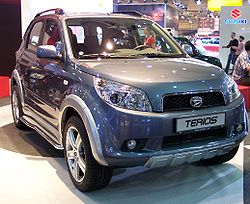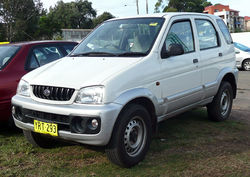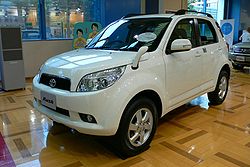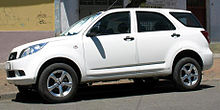- Daihatsu Terios
-
Daihatsu Terios 
Manufacturer Daihatsu Motor Company Production 1997–present Class Mini SUV Body style 4-door wagon The Daihatsu Terios is a mini SUV, first released in 1997 by the Japanese car manufacturer Daihatsu. The engines are a modified Daihatsu Charade 1.3 litre or kei car 660 cc unit, with constant four wheel drive (4WD) or two wheel drive (2WD), respectively. It has 5-speed manual transmission or 4-speed automatic transmission. The width of the first generation Terios is less than 1500 mm, to fulfil the kei car regulations. Also to meet these regulations, the kei car Terios is shorter, losing the rearmost side window. The second generation of Terios was co-developed by Daihatsu and fellow Japanese manufacturer Toyota.
Contents
First generation
First generation 
Also called Toyota Cami
Dario Terios (China)
Daihatsu Taruna (Indonesia)
Perodua Kembara (Malaysia)Production 1997–2005 Engine 659 cc EF-DEM/EF-DET turbo I3
1.3 L HC-EJ SOHC I4
1.3 L K3-VE DVVT DOHC I4Transmission 4-speed automatic
5-speed manualRelated Zotye 2008 (copied illegally[citation needed]) The first generation was available as 4-door estate, and the smaller kei car model called the Terios Kid, which was only released in Japan (see Japanese-language article Terios Kid).
In 2000, Daihatsu gave the Terios a mild facelift both in the exterior and interior of the vehicle. A new chrome grille replaced the black plastic grille. The high-grade model gained electric front windows, central locking, rear seat head restraints, alloy wheels, roof rails and a roof-mounted rear spoiler. Mechanically, the 1.3 litre SOHC four-cylinder engine fitted to the previous model had been replaced by the new 1.3 litre DOHC four-cylinder engine. Power was also increased by 3 kW (4 hp). A sport version of the K3-VET engine was produced in Japan.
In Australia, a limited edition sports series was introduced in 2001 with only 200 units being available. The vehicle had body colour matching bumpers, different from the two-tone bumper colour on the standard model. Rear spoiler and sunroof became standard. The interior was updated with metallic paint finish on the centre console and dashboard.
Versions
- Terios (first generation)
- J100G 1997-1999 "HC-EJ" SOHC 1295 cc engine 89 PS (65 kW; 88 hp) 4WD
- J102G 2000-2004 4WD
- engine "K3-VE" DOHC 1297 cc engine 92 PS (68 kW; 91 hp)
- engine "K3-VET" DOHC 1297 cc Turbo engine 140 PS (103 kW; 138 hp)
- J122G 2000-2004 2WD type ( K3-VE / K3-VET )
- Terios Kid (still available in Japanese domestic market as kei car)
- J111G ( EF-DEM ) 1998-2005 Light pressure turbo 659 cc 4WD 60 PS (44 kW; 59 hp)
- J111G ( EF-DET ) 1998- Inter cooler turbo 659 cc 4WD 64 PS (47 kW; 63 hp)
- J131G ( EF-DEM ) 1998-2005 Light pressure turbo 659 cc 2WD 60 PS (44 kW; 59 hp)
- J131G ( EF-DET ) 1998- Inter cooler turbo 659 cc 2WD 64 PS (47 kW; 63 hp)
- Terios Lucia (limited edition)
- J111G / J131G for 2002 only; variation of Terios Kid (without spare tire)
International
The first-generation Daihatsu Terios is also known as Toyota Cami. In Malaysia, the car is locally assembled as the Perodua badge as Perodua Kembara.
In India it is known as Premier Rio from Premier Auto Ltd. powered by a Peugeot 309 Diesel and petrol engine.
In China it is known by two ways: one of them as under the badge as Zoyte Nomada propelled with a 1.6-litre engine provided by Mitsubishi (first series body); as an unauthorized copy of the car, which caused some controversy, and the FAW badged it as the Huali Terios.
Since 2009, Daihatsu withdrew from the China market due to bad performance, and sold the tooling and rights of this car to First Auto Works (FAW), who has been their partner in China. The new name now is the FAW (or YiQi) M80 SenYa (森雅). Two versions 1.3L(K3) and 1.5L(3SZ) are sold, with variations of 5 seater and 7 seater. Both engines are imported Toyota DVVT engines.
In Indonesia a version of the Terios is known as the Daihatsu Taruna, with a longer rear-based body capable of seating seven people. The Taruna was launched in 1999 with a different fascia and a 1589 cc HD-C petrol engine. The name Taruna translates roughly as "young knight" in Indonesian. It is available with standard CS, CL, and FL trims; deluxe CX and FX trims; and sporty CSX and FGX trims.
A more "stylish" version, the Daihatsu Taruna OXXY, was launched in March 2005.[1]
Second generation
Second generation 
Also called Daihatsu Be‣go (in Japan and China)
Toyota Rush
Daihatsu Terios Eco (Turkey)
Daihatsu Terios Wild (Chile)
Perodua Nautica (in Malaysia)Production 2006–present Engine 1.5 L 3SZ-VE I4 Wheelbase 2,580 mm (101.6 in) Length 4,055 mm (159.6 in) Width 1,695 mm (66.7 in) Height 1,690 mm (66.5 in) Curb weight 1,170 kg (2,579 lb) The second generation known as Daihatsu D-Concept 4x4 made an appearance in 2005 at the Tokyo Motor Show before being named the new Daihatsu Terios, which went into production in 2006.
The second generation of the Terios is also wider, nearly 1700 mm, compared to the first generation which is less than 1500 mm.
On the Japanese Domestic Market (JDM), the Terios has been succeeded by the Daihatsu Be‣go and Toyota Rush, however, in European, South American and most other Asian markets, the new model is sold under the name Terios. Daihatsu designs and manufacture the Terios and also supplies the vehicle to Toyota under a consigned / OEM manufacturing agreement. [2]
Both use 1.3 litre or 1.5 litre engine; diesel engined versions are awaited. Only the 1.5 litre version is available with both two- or four-wheel drive.
The Terios features a permanent 4WD system via lockable central differential. However, it lacks low ratio gears.
In December 2006, Toyota and Daihatsu in Indonesia launched the second generation of Rush and Terios which have longer wheelbases and offer 2 rows, or 3 rows of seats for 7 passengers. However, the car only comes with rear wheel drive.[3] The long wheelbase version of the Terios is also marketed as the "Terios Advantage".
A long-wheelbase version of the Daihatsu Terios was also offered by UMW Toyota in Malaysia as a Toyota Rush, starting February 2008. The vehicle is imported from Indonesia, manufactured by Astra Daihatsu Motor. The Toyota Rush in Malaysia comes in 2 trim levels – the 1.5G (in both 4-speed automatic and 5-speed manual) and the 1.5S. The key differences between these trims are:
1.5S 1.5G Headlamps Projector Multi-reflector Wing Mirror Chrome, retractable Body-coloured 3rd brake lamp LED Bulb Spoiler Standard (with high mount stop lamp) Without Safety ABS, EBD & Dual Airbag Only driver airbag At around the same time, Perodua, Daihatu's local partner in Malaysia also launched a short wheel base version of the Daihatsu Terios. Sold as the Perodua Nautica, it was launched in Malaysia in May 2008. This was fully imported from Japan, except for the front grille, front bumper and rear bumper which are manufactured and fitted in Malaysia. It has a 1.5 litre DVVT engine, full-time 4WD, projector headlamps, a 5-seater with dark interior. The price tag of the Perodua Nautica is not much different from the long-wheelbase Toyota Rush. It comes with only two colour choices: (Medallion Grey and Majestic Black) and comes in automatic transmission only. The Nautica was quietly discontinued in 2009, slightly less than a year after its launch. Only a mere total of 489 units were ever sold.[4] The reason for the discontinuation was because as a national car company focused on local manufacturing, Perodua was unable to obtain sufficient necessary Approved Permits for vehicle importation, as the Nautica was imported in CBU form from Japan.[citation needed]
References
- ^ Astra Daihatsu launched Daihatsu Taruna OXXY[dead link]
- ^ "Daihatsu 2010 Annual Report". http://www.daihatsu.com/ir/library/pdf/annual10.pdf.
- ^ Astra Daihatsu launched Daihatsu Terios[dead link]
- ^ Malaysian Automotive Association Total Industry Volume.
External links
Current vehicles: Atrai/Hijet · Be-go/Terios · Boon/Sirion · Coo/Materia · Copen · Mira/Cuore/Charade · Mira Cocoa · Move · Tanto · Tanto Exe · XeniaPast vehicles: Altis · Applause · Bee · Ceria · Charade · Charmant · Compagno · Cuore · Consorte · Domino · Esse · Leeza/Leeza Spyder · Fellow Max · Max · Midget · Mira Gino/Trevis · Naked · Opti · Gran Move/Pyzar · Rocky/Feroza/Sportrak · Rugger/Rocky/Fourtrak · Sirion/Storia · Sonica · Taft/Scat · Taruna · Valera · YRVConcept Cars: ai · Basket · Copen (1999) · Costa · D-Bone · D-Compact X-Over · Deca Deca · Extol · EZ-U · FFC · HVS · Micros-3R · OFC-1 · SK-Tourer · SP-4 · U4B · UFE2 · UFE-III · X-021 · Mudmaster CRace Cars: P3 · P5Categories:- Daihatsu vehicles
- Off-road vehicles
- All wheel drive vehicles
- Mini SUVs
- 1990s automobiles
- 2000s automobiles
- Vehicles introduced in 1997
- Terios (first generation)
Wikimedia Foundation. 2010.


